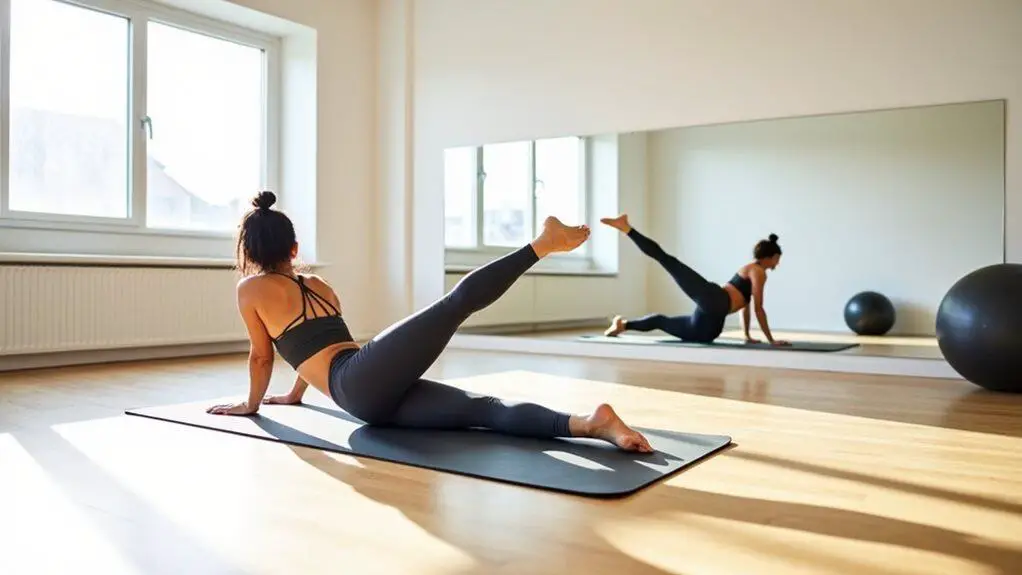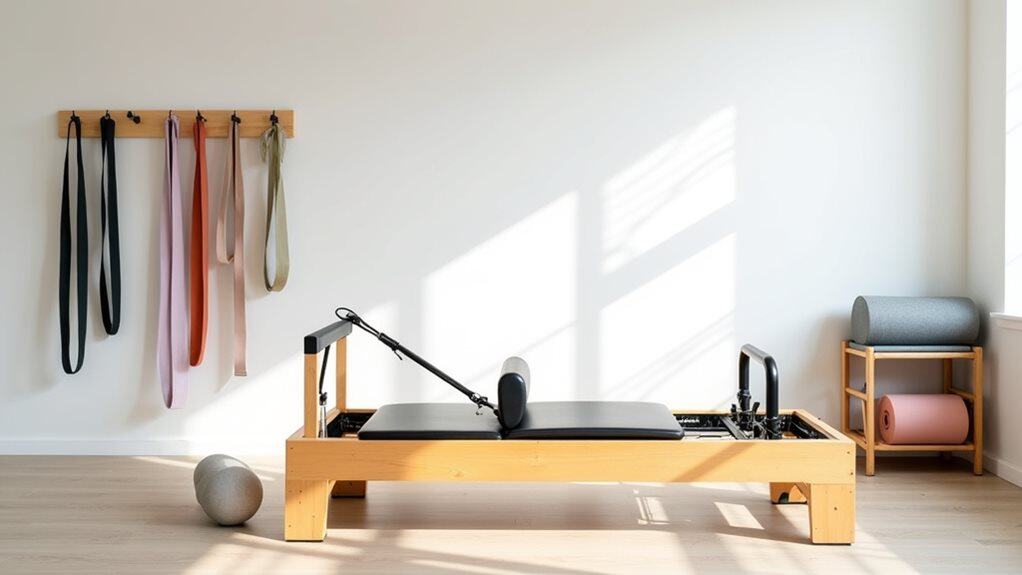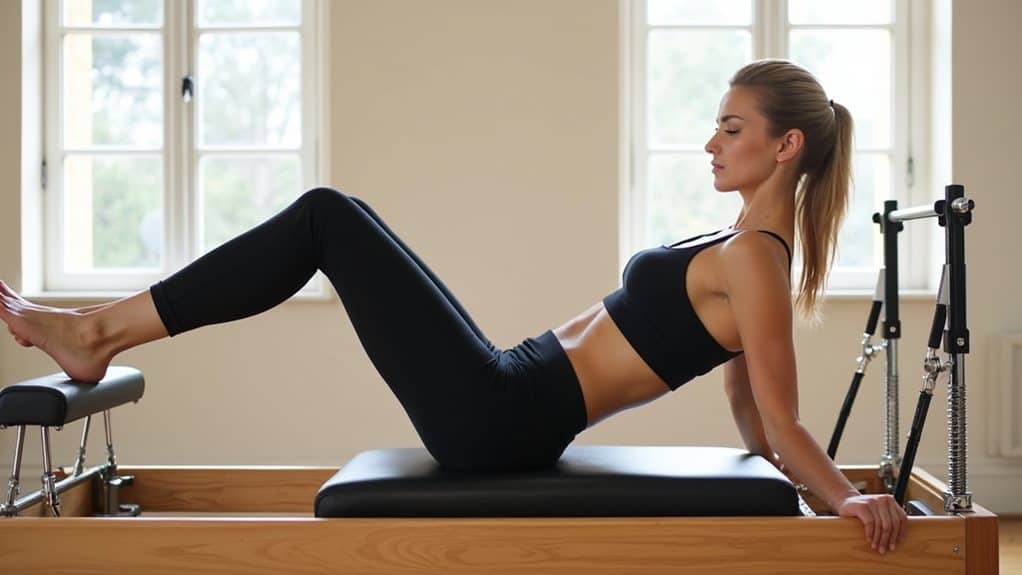In a world increasingly aware of the importance of physical health, it’s essential to understand how different exercise forms can influence various parts of our body. One specific area that often becomes a concern, especially with age or due to sports injuries, is the knee joint—a critical component for basic mobility. Among the many options that claim to offer supportive regimes, one exercise modality gently emerges from the pack, promising an engaging, whole-body approach to fitness that doesn’t neglect our vulnerable joints.
Pilates can be beneficial for bad knees. It emphasizes controlled, low-impact movements that improve flexibility, strength, and balance, reducing knee strain. It also helps build core stability, indirectly supporting knee health. As always, consult with a healthcare professional first.
Let’s thoroughly examine this physical fitness system’s potential implications for those struggling with knee complications.
Understanding Knee Health: The Role of Exercise
Our knees are the most complex joints, bearing the brunt of our weight while enabling a wide range of motion. They consist of bones, cartilage, ligaments, and tendons that work together to facilitate movement and support our body weight. Given their vital role, maintaining knee health is crucial for overall mobility and quality of life.
Regular exercise helps in weight management, reduces knee stress, and strengthens the muscles surrounding the knee joint, offering additional support and stability. Moreover, it enhances joint flexibility and promotes better blood flow, which is essential for cartilage health.
Despite the clear benefits of exercise for knee health, it’s important to note that not all exercise forms benefit individuals with knee issues. Some high-impact or strenuous activities can exacerbate knee problems by putting more pressure on the joint, leading to increased pain and potential injury. That’s where the role of low-impact exercises, which are gentle on the joints, comes into play.
They offer the benefits of movement and muscle strengthening without causing undue strain. As we delve deeper into understanding the influence of specific exercise types on knee health, we’ll explore whether Pilates – renowned for its low-impact and balanced approach – could be a suitable option for maintaining and improving knee health.
How Pilates Supports Joint Health
Pilates is an exercise regime that stands out due to its comprehensive approach to physical health. It aims to enhance flexibility, increase muscle strength and endurance, and improve balance and coordination. Each element is crucial in supporting joint health, including the knees.
The strength aspect of Pilates often focuses on core muscles—the abdominals, lower back, and hips—but it also extensively involves the muscles around the knee joint. By strengthening these supportive muscles, Pilates provides the knee with greater stability and balance, reducing the likelihood of injury due to misalignment or instability. Additionally, the increase in muscle strength aids in shock absorption, preventing direct stress on the knees during everyday movements.
Flexibility, another key pillar of Pilates, is crucial in maintaining a healthy range of motion for joints. Pilates promotes a more flexible body through various stretches and fluid movements, reducing knee stiffness, which could otherwise limit movement and cause discomfort.
Lastly, Pilates is known for its emphasis on controlled, mindful movements. This aspect benefits joint health by encouraging awareness of body alignment and movement patterns. This can help individuals avoid movements that may place undue stress on their joints, potentially leading to injury.
Combining strength, flexibility, and mindful movement, Pilates provides a well-rounded approach to exercise that supports joint health and overall physical well-being.
Specific Pilates Movements for Knee Rehabilitation
Pilates offers a variety of movements that can be particularly beneficial for individuals seeking knee rehabilitation. Always remember, though, it’s crucial to consult a healthcare professional before beginning any new exercise regimen, especially when dealing with injuries or chronic conditions. Here are a few Pilates exercises that are typically recommended for knee health:
- Leg Circles: This exercise helps build stability and strength in the hip joint and the muscles surrounding it, indirectly supporting the knees. Lying on your back, one leg is raised to the ceiling and circled in controlled movements while the other leg stays flat on the ground.
- Single Leg Stretch: While lying on your back, one knee is pulled into the chest while the other is extended, hovering above the ground. This movement strengthens the abdominal muscles, promoting better overall stability and balance, which can contribute to knee health.
- Footwork on the Reformer: Pilates reformer exercises offer a great way to build lower body strength without putting much stress on the knees. Footwork on the reformer involves pushing the carriage while maintaining control and alignment, working the leg muscles.
- Side-lying Leg Lifts: This exercise targets the hip abductors, contributing to knee stability. Lying on one side, with legs stacked and the body aligned, the top leg is lifted and lowered slowly and controlled.
- Bridging: This involves lying on your back with knees bent and feet flat on the ground, then lifting the hips to form a straight line from knees to shoulders. It strengthens the glutes and hamstrings, which support the knees.
Incorporating these exercises into a routine can be beneficial for knee rehabilitation. However, paying attention to form and technique is important to ensure these exercises provide benefits without causing additional strain or injury.
Enhancing Knee Strength and Stability with Pilates
Pilates can be a potent tool for enhancing knee strength and stability, owing to its focus on balanced muscle development, proper alignment, and mindful movement. Here’s how this multifaceted fitness system can help fortify our knees:
- Muscle Development: The exercises in a typical Pilates routine target various muscles, including those that support our knees. By building the strength of the quadriceps, hamstrings, and calf muscles, as well as the smaller, often neglected muscles around the knees, Pilates exercises can better equip the knee joint to handle the stresses of daily activities and reduce the risk of injury.
- Core Strength: The strength of our core—comprising our abdominals, pelvic muscles, lower back, and hips—plays a significant role in maintaining the overall balance and stability of our bodies. A strong core supports better posture and alignment, decreasing the load and strain on the knees. Pilates’ central focus on developing core strength indirectly benefits the knees by promoting better biomechanics and movement efficiency.
- Alignment and Form: Pilates encourages awareness of body alignment and the importance of performing movements with precision. This conscious approach to exercise can help individuals avoid movement patterns that may cause knee strain or exacerbate existing knee issues. For instance, engaging the proper muscles during movement can prevent the knees from moving inward or outward, a common issue leading to knee pain or injury.
- Flexibility: Lastly, the increased flexibility from consistent Pilates practice can enhance joint mobility and decrease the risk of knee injuries related to stiffness or lack of range of motion. Pilates stretches help lengthen and balance the musculature surrounding the knee, alleviating undue tension that could impact the joint’s function.
Remember, while Pilates can significantly contribute to knee strength and stability, it is not a replacement for medical advice or treatment. Always consult a healthcare professional before starting a new exercise regime, especially when dealing with knee problems.
Safety Precautions: Doing Pilates with Knee Issues
Engaging in physical activity when you have knee issues requires careful consideration and precaution to prevent exacerbating the problem. When it comes to Pilates, here are some safety guidelines to keep in mind:
- Consult a Professional: Before starting any exercise regimen, it’s important to consult with a healthcare professional, ideally one with expertise in orthopedics or sports medicine. They can provide personalized advice based on your specific condition, taking into account your medical history and current physical status.
- Work with a Certified Pilates Instructor: A certified Pilates instructor can help ensure your exercises are safe and suitable for your condition. They can also provide instruction on proper form and technique, which is critical for avoiding further knee injury.
- Listen to Your Body: Pain is your body’s way of telling you something isn’t right. If you feel pain during any exercise, stop and notify your instructor. They can provide modifications or alternative exercises that are safer for your knees.
- Maintaining Proper Alignment: Attention to body alignment is crucial when performing Pilates exercises. Misalignment can lead to increased pressure on the knees and potential injury. Your instructor can provide feedback and corrections to help maintain proper alignment.
- Start Slowly and Gradually Progress: It’s crucial to start with simple, low-intensity exercises and gradually increase the difficulty as your strength and flexibility improve. Rushing into complex movements or high-intensity exercises could lead to unnecessary strain and injury.
- Incorporate Rest and Recovery: Rest is as important as exercise for healing and strengthening the knees. Be sure to give your body adequate time to recover between workouts.
- Stay Hydrated and Maintain a Healthy Diet: Proper nutrition and hydration can support healing and reduce inflammation.
Adhering to these precautions can help ensure that your Pilates practice contributes to knee rehabilitation and overall health rather than causing further harm.
Continuing Knee Health: Long-Term Benefits of Pilates
Pilates is renowned for its focus on core strength, but the benefits of this comprehensive fitness system extend well beyond the midsection. Its low-impact, mindful approach to exercise makes it particularly beneficial for joint health, especially that of the knees. Here’s how regular Pilates practice can contribute to long-term knee health.
- Pilates and Knee Anatomy: An Overview: The knee is a complex joint that bears much of the body’s weight. In Pilates, many exercises are designed to strengthen the muscles surrounding the knee joint, providing increased support and reducing the strain on the knees. This particularly benefits individuals prone to knee injuries or knee-related issues such as arthritis or ACL tears.
- Balance and Stability: Safeguarding the Knees: Pilates enhances balance and stability by strengthening the core and improving body awareness. Better balance equates to less risk of falls and associated knee injuries. Moreover, the increased stability can lead to better alignment and biomechanics during movement, decreasing the risk of improper loading and wear on the knees.
- Flexibility and Range of Motion: Regular Pilates practice can improve flexibility and increase the range of motion in the knee joint. This not only helps to prevent injuries but also aids in recovery if an injury occurs.
- Mindful Movement: Key to Joint Preservation: Pilates encourages mindful, controlled movement to benefit knee health. Practicing Pilates teaches individuals to move with precision and control, minimizing undue stress on the knees and other joints.
- Customization: Addressing Individual Needs: Pilates workouts can be easily adapted to cater to individual needs and limitations. If certain movements cause knee discomfort, exercises can be modified, or alternative exercises that still provide a challenging workout without compromising knee health can be chosen.
In the long run, incorporating Pilates into your fitness regimen can significantly contribute to knee health. By strengthening surrounding muscles, improving balance and flexibility, and promoting mindful movement, Pilates offers a robust, low-impact solution to maintain and improve the health of your knees.
Sources:
https://www.pilatesanytime.com/Pilates-Blog/1258/Pilates-for-Healthy-Knees
https://www.healthline.com/nutrition/pilates-benefits




